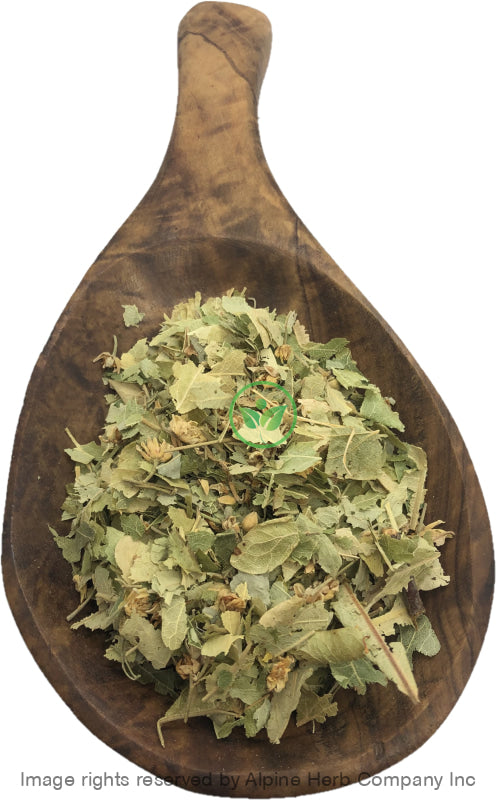Linden Leaves & Flowers Cut Alpine Herb Company Inc.
$ 15,99 $ 9,59
Botanical Name: Tilia europaea
Common Name:
- English: Linden
- Also, known as: Lime Tree, Basswood, Small-leaved Lime, Common Lime, and European Linden
Origin: Pakistan
Harvested: Wild
Parts Used: Leaves and Flower
General Information:
Tilia europaea, commonly called European linden, is a hybrid cross between two native European lindens, Tilia cordata, and Tilia platyphyllos. It is perhaps most like its Tilia platyphyllos parent. Linden is also known as a lime tree and basswood.
The tree grows to a height of about 30-40 meters and has clusters of fragrant yellow-white flowers, followed by green fruits. The leaves are heart-shaped, dark green on the upside, the underside is a little yellowish-green. Leaf buds are red, with one small scale and one large scale, resembling a boxing glove, and form on long leaf stalks. The leaves are 3-6-inch-long and 2.5-5 inch wide. Fall colour is an undistinguished pale green to pale yellow. The flowers are white-yellow, five-petalled, form cymes with up to 10 flowers and have a drooping habit. The hanging cymes are up to 5-7 cm long. The flowers smell strong. Limes are hermaphrodite, meaning both the male and female reproductive parts are contained within one flower. When a tree is in full bloom, bees often visit in such abundant numbers that humming can be heard many feet from the tree. The fruits are green spherical nutlets, once pollinated by insects, they develop into round-oval, slightly ribbed fruits, with a pointed tip. The bark is pale grey-brown and irregularly ridged, with characteristic large burrs and leaf shoots at the base of the tree. Twigs are slender and brown, although they become red in the sun.
How to use:
Hot Infusion:
The basic method for dried herbs and flower is, take 2-3 tablespoons of dried herb in a cup or teapot. Pour hot water over it and cover it with lid for 10-30 minutes. Hot water is needed to draw out the antioxidants, enzymes, vitamins, flavonoids, and volatile oils from the botanicals. Strain and squeeze out as much as liquid as possible and enjoy it!
Tips:
- You can sweeten your herbal tea with a bit of honey, natural fruit juice, stevia leaves powder and or licorice root powder.
- You can make ice cubes or pops by freezing tea in ice trays or pop molds.
Precautions:
You should consult with a qualified healthcare practitioner before using any herbal products, particularly if you are pregnant, nursing, or on any medications.
All information on this website is for educational purposes ONLY.
This information has not been evaluated by Health Canada.
This information is not intended to diagnose, treat, cure, or prevent any disease.
| Unit Size | 100g, 200g, 400g, 1kg |
|---|
Prompt shipping and expert packing
Thanks to our longstanding association with UPS FedEx DHL as well as other leading global carriers, we can offer a variety shipping options. Our warehouse staff is highly trained and will be able to pack your goods in accordance with our precise and exact specifications. Your items will go through an exhaustive examination before they will be securely packaged before being delivered. We ship to hundreds of thousands of customers daily in different countries. This is a sign of our determination to become the largest online retailer worldwide. Warehouses and distribution centers are located throughout Europe as well as in the USA.
Note that orders containing multiple items are processed according to the particular item.
We will thoroughly inspect all items ordered before shipping. Most orders are shipped within 48 hours. The delivery time will be between 3 and 7 working days.
Returns
The stock market is always changing. It's not entirely managed by us since we're involved with several entities, including the factory and the storage. Therefore, the actual inventory could fluctuate at any moment. Please be aware that it is possible that your order could be out of stock after you've placed your order.
Our policy lasts for 30 days. If it's been more than 30 days since the date you purchased your item We're sorry to say that we can't offer you a full exchange or refund.
You can only return a product if it is unused and still in the same state as when you received it. The item should be in the original packaging.


































